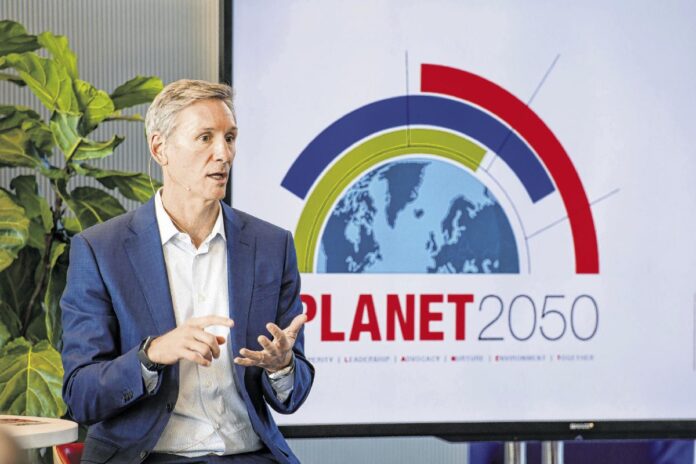
INDIANAPOLIS — Cummins Inc. has unveiled a new environmental sustainability strategy to combat climate change and conserve natural resources — including company-wide targets aimed at achieving carbon neutrality by mid-century.
Named “PLANET 2050,” the strategy seeks to reduce greenhouse gas emissions, promote the sustainable use of natural resources and help communities, said Cummins Chairman and CEO Tom Linebarger.
He announced the strategy Friday during an employee town hall in Indianapolis at the company’s distribution headquarters.
“There’s no question that as one of the world’s leading suppliers of diesel engines, we have a big environmental footprint,” Linebarger said. “We have not only the will to do (address climate change), we have a responsibility to play our role in improving the price we pay in environmental footprint for the wealth we deliver. We have to get that ratio changed. …Some of these goals, we don’t really exactly know how to get to, but that’s where innovation comes from, doesn’t it?”
[sc:text-divider text-divider-title=”Story continues below gallery” ]Click here to purchase photos from this gallery
The strategy includes eight goals for 2030 and additional targets for 2050. The 2030 goals include reducing greenhouse gas emissions from all the company’s facilities and operations by 50%, reducing water consumption by 30%, reducing lifetime greenhouse gas emissions from new products by 25% and reusing or recycling all packaging plastics.
The 2050 targets include carbon neutrality and near-zero pollution at Cummins facilities and operations and eliminating waste in products and processes, among other targets.
About 99% of Cummins greenhouse gas footprint comes from the use of the company’s products after they’ve been sold, Linebarger said.
The goals for 2030 and 2050 are based on the United Nations Sustainable Development Goals, analyzing best practices worldwide, among other things, said Brian Mormino, executive director of worldwide environmental strategy and compliance at Cummins.
Additionally, the company’s strategy meets or exceeds the goals laid out in the landmark Paris Agreement on climate change, company officials said.
The Paris Agreement, signed by the leaders of 195 countries in 2016 — including former President Barack Obama — seeks to accelerate the world response to climate change by reducing greenhouse gas emissions in an effort to prevent global temperatures from rising more than 1.5 degrees Celsius this century.
On Nov. 4, the Trump administration notified the United Nations Secretary-General that the U.S. will withdraw from the Paris Agreement effective Nov. 4, 2020, the day after the U.S. presidential election, according to the United Nations’ website.
“We’re trying to set the guideposts in line with the experts and the science so that we know where we’re headed and then we can back that up and have specific, quantifiable 2030 goals,” Mormino said during the employee town hall.
Linebarger said he is optimistic that Cummins can meet the new goals, but will need to make “incredibly dramatic” changes and overcome several obstacles, including a lack of economically-viable technology.
“Most of our customers are unwilling to pay more for a product that’s cleaner,” Linebarger said. “When you think about it, there are a lot of challenges here that are really important, but the biggest environmental footprint and the biggest thing that we have to do is to make the engines have a smaller environmental footprint while doing the same or more amount of work for the customer.”
The United States has one of the largest carbon footprints in the world and is responsible for 5,270 metric tons of carbon dioxide emissions in 2017 — second most in the world, according to the most recent data from the Global Carbon Project, which records carbon dioxide emissions around the world.
Also, two major international markets for Cummins — China and India — are among the world’s top polluters. China was responsible for 9,839 metric tons of carbon dioxide in 2017 — the most of any country in the world. India emitted 2,467 metric tons of carbon dioxide in 2017, or third most worldwide.
Linebarger said Cummins is working to influence public policy in emerging market economies whose economic policy may be more geared toward growth than sustainability.
“We’re very active in all the markets we’re in to try to drive a better regulatory framework, drive new technology implementation in the markets and to demonstrate that they can do it at relatively effective costs,” Linebarger said.
“When we’re talking about big changes in technology and infrastructure, these things do not happen fast,” he said.
[sc:pullout-title pullout-title=”Where to learn more” ][sc:pullout-text-begin]
Visit cummins.com/company/global-impact/sustainability for more information about Cummins’ sustainability goals.
[sc:pullout-text-end]




